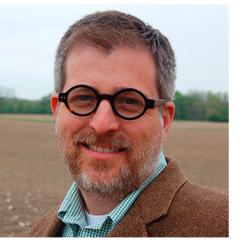Sterling College, a small liberal arts institution in northern Vermont, has a long history of environmental stewardship. It was one of the first colleges to combine liberal arts study and sustainability in its curriculum. Enrollment is puny — about 110 students this fall, making Sterling the smallest year-round college in the U.S. — but the school is surrounded by idyllic boreal forest. Its campus, in the town of Craftsbury Common, is quintessential Vermont, sprawled across 130 acres of rolling hills, wetlands, pastures and organic gardens.
When it comes to investment management, Sterling is hardly a powerhouse. Its endowment amounts to just $1 million, a tiny speck in the $406 billion universe of U.S. college endowments. So when Sterling earlier this year signed on to the fossil fuel divestment campaign started by environmental activist Bill McKibben and his 350.org, the school couldn’t have known that it would serve as a touchstone in a campaign that has put some of the largest college endowments in the U.S. on the defensive.
Since McKibben and a grassroots alliance embarked on a climate crusade soon after the devastation of Hurricane Sandy last October, six schools have committed to divest from fossil fuels. In addition to Sterling, they include Vermont’s Green Mountain College; Unity College and College of the Atlantic, both in Maine; Massachusetts’ Hampshire College; and San Francisco State University.
Not that these institutions, which have combined endowments of less than $130 million, held substantial fossil fuel assets in the first place. But even though their actions will have little to no measurable economic impact on the share prices of big oil companies such as Exxon Mobil Corp. and Royal Dutch Shell, their decision to divest has helped ignite a debate in the halls of academia and beyond. Student-led petitions are spreading, and interest is catching on among local governments, religious groups and other organizations.
“I don’t think we’ve seen anything this big before,” says Craig Metrick, U.S. head of responsible investment at Mercer in New York. “Endowments and municipalities have stated they will divest and/or are considering divesting.”
In many ways, the campaigns are reminiscent of the divestment battles waged against apartheid in South Africa and big tobacco companies. In the 1980s students across the U.S. put up tents and staged antiapartheid hunger strikes and protests to persuade their school administrators to stop investing in companies doing business in South Africa. By the end of the decade, more than 150 colleges and universities had agreed to take economic action. The antitobacco movement during the ’90s was less widespread, but more-recent actions by students protesting against owning shares of companies doing business in Sudan, arising from concern over the human rights crisis in the Darfur region, have influenced many institutions’ investment policies.
McKibben and his supporters are hoping for similar momentum on the fossil fuel front. However, the response from most major college endowments has been mixed thus far. Harvard University initially indicated it would not consider divesting, although it recently created the position of vice president for sustainable investing. Bowdoin College, in Maine, and Ithaca, New York–based Cornell University have rejected demands by their students. Others, such as Brown University in Providence, Rhode Island, and Vermont’s Middlebury College, appear to be taking divestment seriously and are in the process of evaluating it. Meanwhile, the pressures are expected to escalate when the new school year begins this fall.
If nothing else, Sterling and its peers have put the onus on the big colleges and universities to make a move or weigh the consequences of inaction, say academics, advocacy groups and investment consultants. For their part, advocates are seeking broader discussions with administrators on socially responsible investing and how and why endowment managers need to integrate environmental, social responsibility and corporate governance principles, or ESG, into the investment process.

Derr thinks that higher education leaders such as Harvard and Yale University may be in a more difficult position, in part because many of them have historically relied on corporations such as Exxon Mobil to fund academic research. These institutions tend to worry about the perils of politicizing campuses. For the most part, they have tried to steer clear of moral or political controversies, except in the case of South Africa, which became a compelling ethical issue that no one could ignore. But at the same time, they want to be seen as adhering to their ethical goals while fulfilling their primary purpose of education.
Derr admits to sounding “a little soapboxy” when he insists that fossil fuel divestment isn’t some sort of niche issue that the biggest endowments can sidestep. “Smaller colleges are doing something important,” he adds, “but that doesn’t let anybody off the hook.”
For endowment managers, however, the situation is more complex because they tend to view things through the prism of fiduciary responsibility. Maximizing returns has been the ruling ideology, and responsible investing tends not to be a part of the financial calculus.
IN 1972 THREE YALE PROFESSORS published a book titled The Ethical Investor: Universities and Corporate Responsibility. At the time one of two seminal studies on the topic of responsible investing, the book held that the university as a corporate shareholder has a “moral minimum” responsibility to try “to prevent or correct corporate social injury,” defined as any activity that violates domestic or international law or impinges upon the individual’s right to health, safety and basic freedoms.
The principles tested the bounds of academic neutrality. But Yale surprised everyone by taking up the challenge and assuming an activist role as a stockholder in U.S. companies. It created the Advisory Committee on Investor Responsibility (ACIR), whose research and recommendations led to divestment from South Africa and Sudan. Other institutions did the same.
In practice, however, the universities were fundamentally divided between morals and money, resisting deepening involvement in nonacademic issues. At Yale the ACIR’s oversight over the endowment’s shareholder proxies was severely limited: The investment office continued to exercise full decision-making powers.
After Yale’s pioneering portfolio manager David Swensen arrived on the scene in 1985, he began shifting the endowment toward international equities and alternative assets in what came to be known as the Yale model of institutional investing. The model was widely emulated, and the push for portfolio diversification became the hallmark of the successful modern endowment.
“Part of what’s changed since we wrote the book is that the endowments’ investment portfolios look very different today, since a huge portion is no longer in traditional equities,” says Jon Gunnemann, co-author of The Ethical Investor and now a professor emeritus of social ethics at Atlanta’s Emory University.
But Swensen’s move was predicated on secrecy for competitive purposes. By and large, Yale’s investment process became profoundly opaque, making genuine oversight next to impossible.
In 2009 the ACIR put out a paper that sought to hold Yale to its commitment to environmental sustainability, social advocacy and business ethics. At the same time, the paper expressed frustration over the school’s ineffectiveness and the lack of transparency of its investment process. The committee, composed of Yale students and alumni, pushed for a package of reforms, including greater transparency that would allow the ACIR to fully analyze the endowment’s investments.
It isn’t clear what reforms, if any, may have come about as a result of the recommendations. Yale and members of the advisory committee did not respond to requests for comments for this story.
For many college endowments part of the evolution toward alternative assets and more-illiquid assets meant that responsible-investing standards were largely confined to negative screening of public equity portfolios, relating to issues such as tobacco, “sin stocks” and targeted divestment from Sudan. “Very little consideration” has been given by college endowments to ESG factors, according to a survey published in July 2012 by the Investor Responsibility Research Center Institute, a New York–based not-for-profit group, and Boston think tank Tellus Institute.
There’s a prevailing perception that responsible investing “means restricting the investment universe,” leading to underperformance, says Mercer’s Metrick. In talking with clients, he says, there are real concerns among investment officers about taking on issues that involve social policy when their job is to maximize returns.
The prospect of lower investment returns is one of the reasons there’s still pushback on fossil fuel divestment. Earlier this year Bowdoin denied a petition by student groups, saying it was not prepared to do so at the time. The college said that about 1.4 percent of its $902.4 million endowment is invested in fossil fuel companies through commingled funds. The investment office projected that substituting a fossil fuel–free index for the commingled funds would have resulted in a 5 percent decline in the average annual return over the past decade.
As one former chief investment officer of a large university endowment, who requested anonymity, maintains, “Our legal, ethical and moral responsibility is to maximize returns, and the goal and purpose of these funds is to support education.”
A further complication lies in deciding which social and moral issues are appropriate for colleges to act upon. Apartheid and genocide may have been clear cases, but carbon falls in a gray area. “We do consume oil, drive cars, heat our homes,” the former CIO explains. “Having a product that excludes fossil fuels is not intellectually honest.”
The problem is as much structural as it is cultural, and college endowments are no different from pension funds and foundations in that sense. “There’s a cultural divide between what you do with your money and what the world needs,” says David Wood, director of responsible investing at Harvard’s Hauser Institute for Civil Society.
Wood believes responsible investing hasn’t gained as much traction as advocates would like to see within the broader institutional investment community. “We’re starting to see some small steps,” he says. “We see that in universities; some are more active than others. But I don’t think they stand out as laggards as much as they may not be living up to their potential as institutional leaders.”
That is why Sterling College’s Derr is intent on stoking debate on fossil fuel divestment. As one of the few who have made the leap, Sterling may be an outlier given its size and unique environmental activism.Yet Derr argues that the school could “also make socially responsible investing as important as the kind of research work we do to invest in hedge funds or other alternative vehicles for improving our returns.”
At Sterling the initiative came not from students but from a small group of board members, including Derr, who wanted to reevaluate how the college could invest the endowment more broadly, beyond the fossil fuel question. At the time, the endowment’s investment portfolio was largely in mutual funds that were not screened for socially responsible investing.
The board members agreed that divestment of fossil fuels was entirely consistent with the college’s mission, even if the portfolio’s exposure to them was minimal. “An investment strategy that depended at any level on fossil fuel extraction made no sense,” Derr says. Sterling recently partnered with Trillium Asset Management, a Boston asset manager exclusively focused on socially responsible investing.
Hampshire College, also exceptionally progressive, went a step further. Since the 1970s the school has employed a socially responsible investment approach that filtered out specific economic sectors, such as tobacco. Earlier this year its board approved a new ESG investing policy that directs investment managers and consultants to actively seek investments in companies whose products and policies are consistent with sustainability. In other words, Hampshire would be more proactive in favoring investments in businesses that provide social benefits, promote fair labor practices, increase employment prospects and support environmental improvements.
Winning over the biggest college endowments remains a tough sell. Even advocates themselves acknowledge that campaigning for fossil fuel divestment may be quixotic. Only about $24 billion of the roughly $406 billion in assets held by higher education institutions is invested in energy and natural resources, including fossil fuels, according to the latest data from the National Association of College and University Business Officers. Even if colleges agreed to divest en masse, that amount “is not nearly enough to have any effect on climate change,” says Kenneth Redd, director of research and policy analysis at Nacubo.
Students say they have to engage administrators and investment professionals in more-constructive ways. At Yale students introduced ESG performance metrics into the fossil fuel divestment discussion. When that happened, “it seemed like the ACIR became a lot more interested in the case for fossil fuel divestment,” says Gabe Rissman, a sophomore who joined the campaign last year and vows to continue working on socially responsible investing issues even after college.
Harvard has taken some action. Earlier this year its $32 billion endowment hired a vice president of sustainable investing to serve as Harvard Management Co.’s in-house expert on ESG issues. The decision to create the position was welcomed in some quarters as an honest and well-intentioned move.
“We are, by the long-term nature of our mission, concerned with responsible stewardship and sustainability, and therefore environmental concerns, labor practices and good governance are key issues that are addressed in our due diligence process before we make any investment,” says Jane Mendillo, president and CEO of HMC, in an e-mailed response to questions by Institutional Investor.
Experts say Harvard and other institutions have integrated ESG into the investment process as risk factors, but such filters may be difficult to implement. If investment managers don’t see a good ESG investment in, say, renewable energy that would fit their criteria, they won’t pull the trigger simply because some clients are interested in responsible investing, say ESG experts.
Still, as with apartheid, many observers see the value of the students’ campaigns in raising the issue of fossil fuels for public debate. For advocates such as Derr, having the debate is just as effective as taking a stand: “To have a consistent voice in the conversation that will lead to asking the right questions about whether the present investment strategy is the right strategy is a great thing.”
Read more about endowments.






